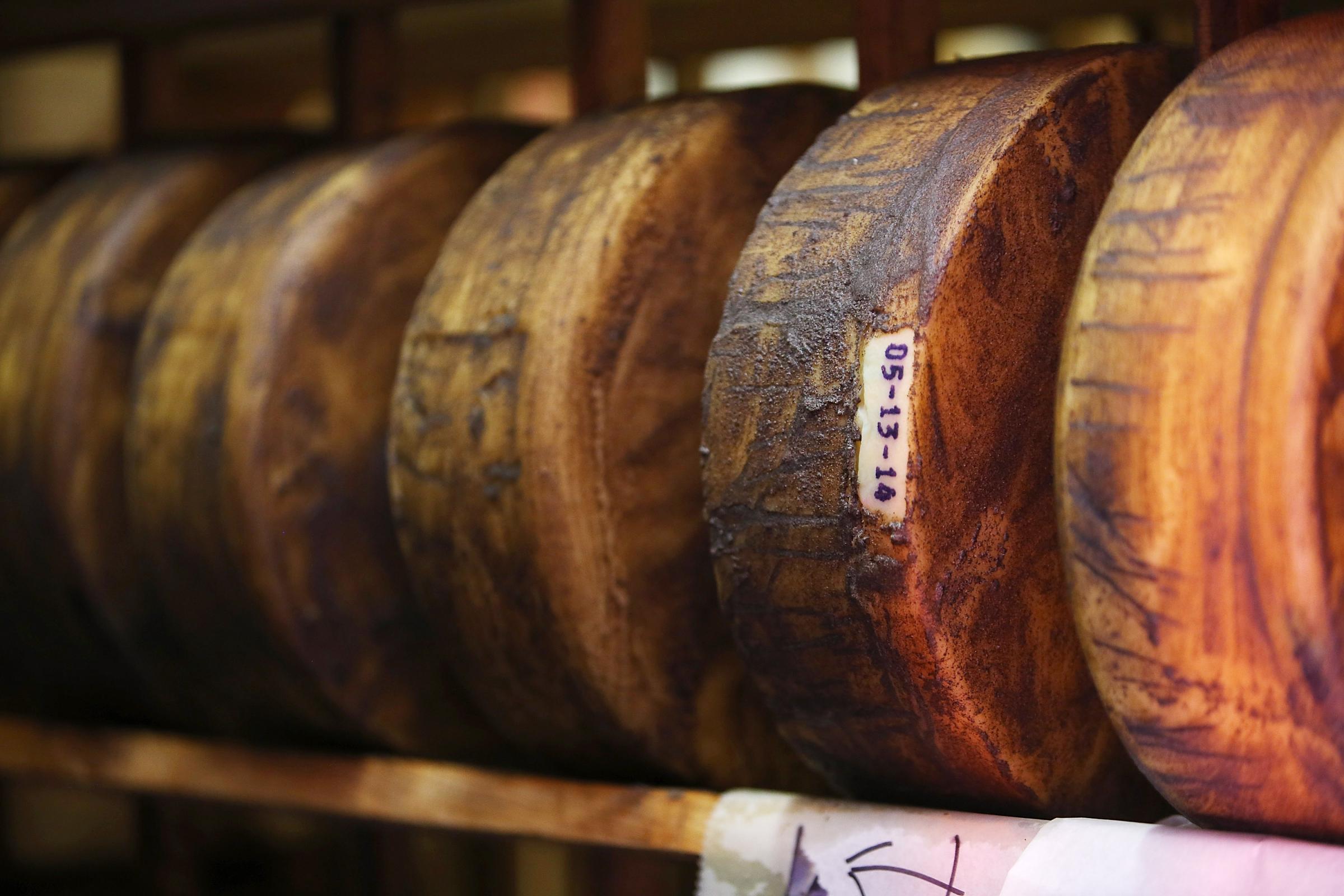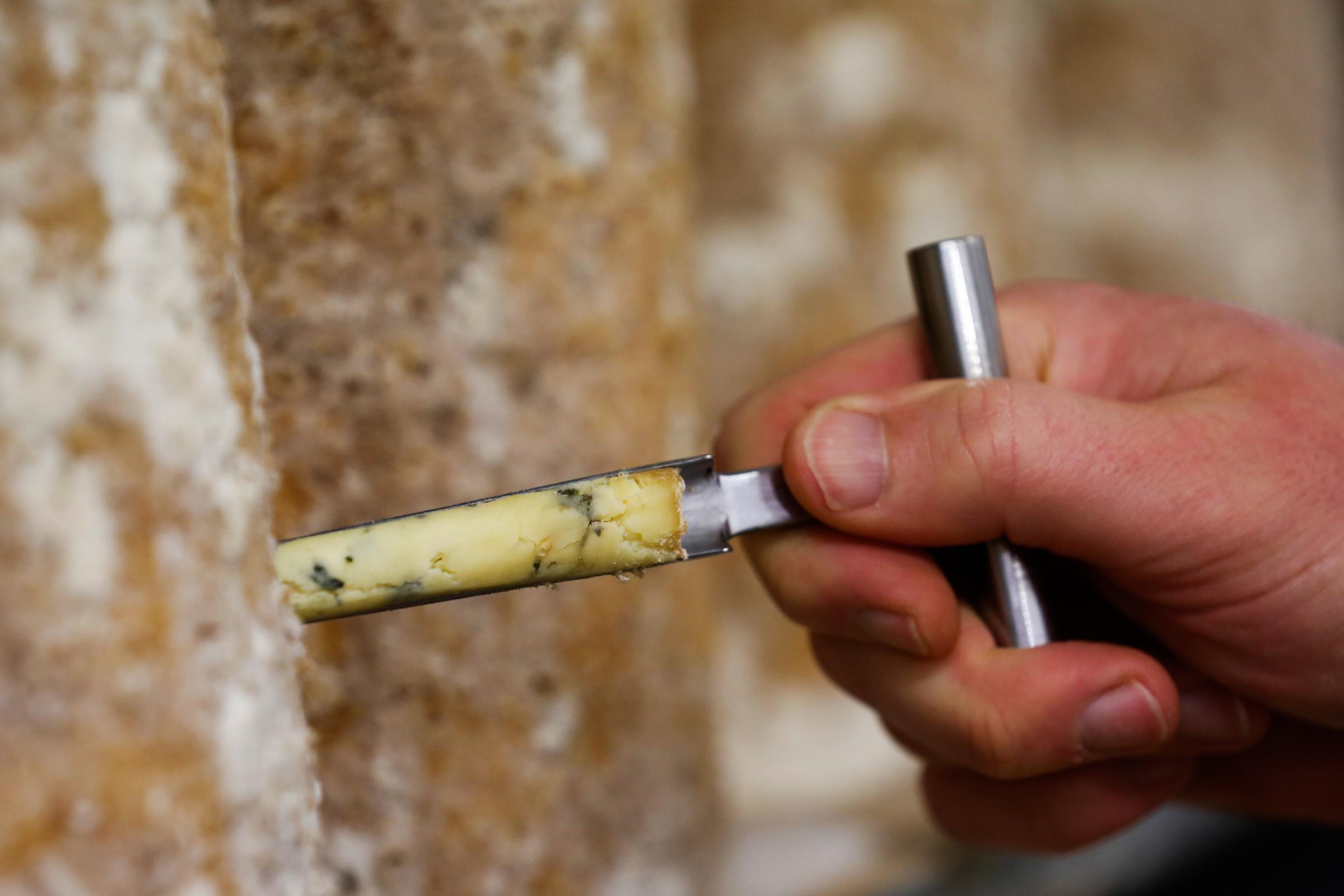
Fuzzy ashen mold billows around wheels of cheese stacked on wooden planks at La Ferme de L’Abérieux. Inside its cheese cave nestled in the hills of Cordon, southeastern France, proprietor Albert Bottollier Depois removes one wheel and lowers it to the wide eyes of two children. “Mushrooms,” he says threading his fingers through the cloudy wreath of fungus forming the cheese’s distinctive crust. For a stronger cheese, he’ll even pierce the rind so it seeps in and blooms in the eyes.
This is a Tomme de Savoie, one of France’s most distinguished and sought-after cheeses. And yet it has seesawed on America’s Import Ban list since 2014—alongside Roquefort, Morbier, and St. Nectaire. Some American artisan cheeses have been kept off market shelves too as the FDA struggled for the last two decades to devise regulations over bacteria in raw milk cheese.
Many cheesemakers have been frustrated by the FDA’s crusade against microbes, considering them impractical and out of step with international standards. It’s “a war against artisan cheese,” says Mateo Kehler, an award-winning cheesemaker from Jasper Hill Farm in Vermont and a vocal advocate for his fellow fromager.
At face value, blacklisting bacteria from cheese production sounds like a no-brainer. But as any turophile knows, microbes are the source of cheese’s vast diversity of flavors, textures, and smells. Other fermented foods like wine, beer, and bread rely on the same phenomenon. Like DNA, every cheese is unique, expressing different tastes depending on all sorts of variables—the microbes in the air, the breed of the cow, richness of the grass, even the altitude of the farm.
“Cheese is mold, and mold is cheese,” explains Thomas Amorim, a 32 year old certified cheesemonger based in Philadelphia, grinning at his own hyperbole.
To prove the point, Amorim whips out Montgomery Somerset, a pale-moon cheddar streaked with veins of blue. It was made by the English fromager James Montgomery, who has a technique of lightly dropping each wheel as it’s being produced. That causes the wheel to fracture and exposes the cheese to the flora in the cave where it ages in Somerset, England. The mold can’t grow anywhere else in the world in exactly the same way, so it serves as Montgomery’s signature—impossible to replicate.

‘It’s not a one-size-fits-all situation’
Letting funky mold grow all over a cheese in a damp English cave doesn’t sit easily with the FDA, however.
As part of the Food Safety Modernization Act (FSMA), the most sweeping food safety overhaul in 70 years, the FDA has implemented Hazard Analysis and Risk-Based Preventive Controls (HARPC)—a system designed to maximize the safety of a food product by identifying risk at every step of its production, and then requiring controls to prevent or minimize those risks. Non-toxigenic E.coli has been identified as a risk, and the FDA initially cut limitations in cheese from 100 most probable number (MPN)/gram to 10 MPN/g in 2009—essentially prohibiting it.
“Non-toxigenic E. coli in dairy products has long been used by FDA and other public health regulatory agencies in the U.S. and other countries as an indicator organism for the presence of fecal contamination, which could indicate unsanitary conditions in a processing plant,” the FDA explained in a statement to TIME.
To be sure, tight regulations of cheese make sense. A typhoid outbreak from poorly kept milk prompted legislation in 1949 requiring pasteurization—a heat treatment for milk that kills harmful bacteria such as listeria and salmonella. The law prevails to this day. Otherwise any cheese made from unpasteurized milk—domestic or imported—must age for at least 60 days to ensure any existing pathogens die out in the aging process.
However, measuring a raw milk cheese’s safety according to non-toxigenic E. coli levels is problematic on several fronts. Heat destroys microbes, so if non-toxigenic E.coli is found on pasteurized cheese, “Then you know something wasn’t right,” likely with post-process contamination, says Kathleen Glass, associate director at the University of Wisconsin’s Food Research Institute.
But as one of the most prevalent bacteria—found on meats, leafy greens, and in the human gut—non-toxigenic E. coli is just one of the many microbes indigenous to raw milk. “For a raw milk cheese…it isn’t necessarily a direct indicator of a disease-causing bacteria,” Glass tells TIME.
“It’s not a one-size-fits-all situation,” explains Nora Weiser, executive director of the American Cheese Society, which represents more than 1,700 cheesemakers, retailers, and distributors. Microbiologically diverse cheeses belie a single contamination criterion, so much of the society’s work centers on lobbying for regulatory recognition of the array of microbes cheese encounters during production.

‘A microbe-free, progressive and genetically engineered future’
Artisanal cheese does not have a perfect track record. Between 1998-2011, one study found 90 outbreaks attributed to cheese, causing 1,882 illnesses, 230 hospitalizations, and 6 deaths. Some 42% of those outbreaks resulted from unpasteurized cheese, 49% from pasteurized, 9% unknown. This year, raw milk cheese caused two deaths in the States.
In these cases, outbreaks resulted from cheeses—many of which were imported illegally or contaminated post-production—tainted with harmful pathogens like listeria, salmonella, and O157:H7 E.Coli, a harmful strain of E.coli that gives the good kind a bad rap.
On the other hand, significant scientific literature corroborates the fact that non-toxigenic E.coli is, well, not toxic. These studies form the basis of standards adopted by International Commission on Microbiological Specifications for Foods (ICMSF), the peak scientific body in its field, and the European Union. Thus, most critics believe testing should focus on disease-causing pathogens instead.
The FDA’s stance on non-toxigenic E. coli has caused uproar in the cheese world. Cheeses like Tomme de Savoie have been placed on Import Alert, many spoiling while detained at ports. Some American producers have halted production of cheeses. Legislators including Bernie Sanders issued a bicameral letter to the FDA. The Oldways Cheese Coalition launched a petition that received thousands of signatures. Even Prince Charles has spoken out against “bacteriological correctness” at the Paris Climate Talks, declaring, “In a microbe-free, progressive and genetically engineered future, what hope is there for the old-fashioned Fourme d’Ambert, the malformed Gruyère de Comté or the odorous Pont L’Eveque?”
After persistent advocacy from the American Cheese Society, the FDA issued a ceasefire in February of 2016, stating it would “[take] another look” at non-toxigenic E. coli’s role as an indicator organism.” And at the ACS annual cheese conference in Denver in July, Jenny Scott, Senior Advisor to the FDA’s Center for Food Safety and Applied Nutrition, said the truce would hold.
“It’s a win for sure,” says Kehler, whose Winnimere and Bayley Hazen Blue came under threat from the FDA’s testing program of over 1,600 foreign and domestic cheeses for non-toxigenic E.coli. (The FDA concluded what previous studies already had shown: there is no correlation between non-toxigenic E.coli and pathogens.)
“Obviously [food safety] is a priority for all of us around the table,” says Spring Brook Farm’s Jeremy Stephenson and President of the Vermont Cheese Council. He attributes a lot of the fumbles to prior misunderstandings, now ameliorated by industry lobbying. “I’m optimistic, not just guardedly so, that we’re set on a good course with our relationship with the FDA and as an industry.”
“For producers like us, making raw milk cheese is at the core of our identity,” says Andy Hatch, the award-winning co-owner of Uplands Cheese in Wisconsin who has also engaged in FDA talks.
Concern remains, albeit less acute than two years ago when some producers just walked away from raw milk cheese. (Even Hatch stopped producing his Rush Creek Reserve amid the 2014 uncertainty.) Nevertheless, the industry’s consecutive victories sustain Hatch’s sense of hope. The FDA first tackled the 60 day aging rule in the 1990s. Then came the review of woodboard aging in 2014, and then again with the E.coli mandate. Artisan cheesemakers won every time.
“I have been frustrated by the way they’ve gone about [regulatory implementation],” says Hatch. “But my hope is that they’ll be more transparent, more communicable, and more in line with international standards.”

‘As restrictive as possible’
Given the FDA’s initial bumps in the road, “Everyone thought [FSMA] was the beginning of the end,” says Bronwen Percival, cheese buyer at Neal’s Yard Dairy in London and co-author of Reinventing the Wheel: Milk, Microbes, and the Fight for Real Cheese. “But when you go back and look at the text, and look at the way [the FDA is] going forward, it’s much closer to the EU system.”
Australia, too, has hopped on this global raw milk cheese bandwagon, albeit with greater reluctance. Until 2012, raw milk cheese production was forbidden. A small but growing industry has forced reconsideration, pointing to E.U. and U.S. models. In a country with a long history of industrial dairy, regulations remain “frustratingly conservative, but heading in the right direction,” says Alison Lansley, Secretary of Australian Specialist Cheesemakers Association. Regulator, she says “particularly when they haven’t come out of tradition, such as Europe has, will always try to make it as restrictive as possible because they don’t want to be responsible for having allowed things to go too far.”
Nowhere else reveres tradition like France, where artisan cheese is a point of cultural and gastronomic pride. State-run organizations like L’Appellation d’Origine Protégée (AOP) exist to ensure prominent cheeses follow specific practices, such as curdling milk within 24 hours of milking to preserve microbes, and traditional methods. Entrants get to bear a blue seal guaranteeing provenance and a higher market price. At one of the 760 cheese-producing farms in France, an AOP poster depicts an elderly female farmer parodying Marilyn Monroe, giddily forcing down her blue apron as hay whirls it up. “Our history hasn’t had a wrinkle,” it says, “since the 14th century.”
Even though America’s history pales in comparison, its artisan cheese industry has made significant inroads in the last two decades. Over 900 artisan cheese farmers operate in the U.S. today—up from 75 in 1990. The burgeoning industry only echoes growing consumer demand. According to the Specialty Food Association, artisan cheese dominated food sales in 2016—a place held since 2007—at $4.42 billion, a 23.4% increase since 2012. SFA projects sales will grow another 21% by 2021. According to CNIEL, France’s Dairy Board, France exported 22,500 tons of cheese to the U.S. in 2015, a 67% increase since 2000.
In other words, the artisan cheese industry is a global force to be reckoned with. High volumes make it even more essential that science and diligence be used to overcome the microbial risks and ensure that everyone can enjoy this gustatory pleasure. Luckily, no one disagrees with that.
“I think it’s so easy to forget that FDA is on the same side. It’s in everybody’s best interest to have safe cheeses on the market,” says Percival. “Everyone is working toward the same goal. Once everyone starts speaking the same language, everything else is easy.”
Reporting for this article was supported by the University of Pennsylvania’s Terry B. Heled Travel & Research Grant.
More Must-Reads from TIME
- Cybersecurity Experts Are Sounding the Alarm on DOGE
- Meet the 2025 Women of the Year
- The Harsh Truth About Disability Inclusion
- Why Do More Young Adults Have Cancer?
- Colman Domingo Leads With Radical Love
- How to Get Better at Doing Things Alone
- Michelle Zauner Stares Down the Darkness
Contact us at letters@time.com